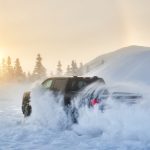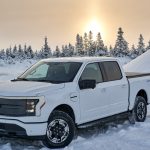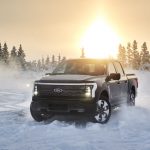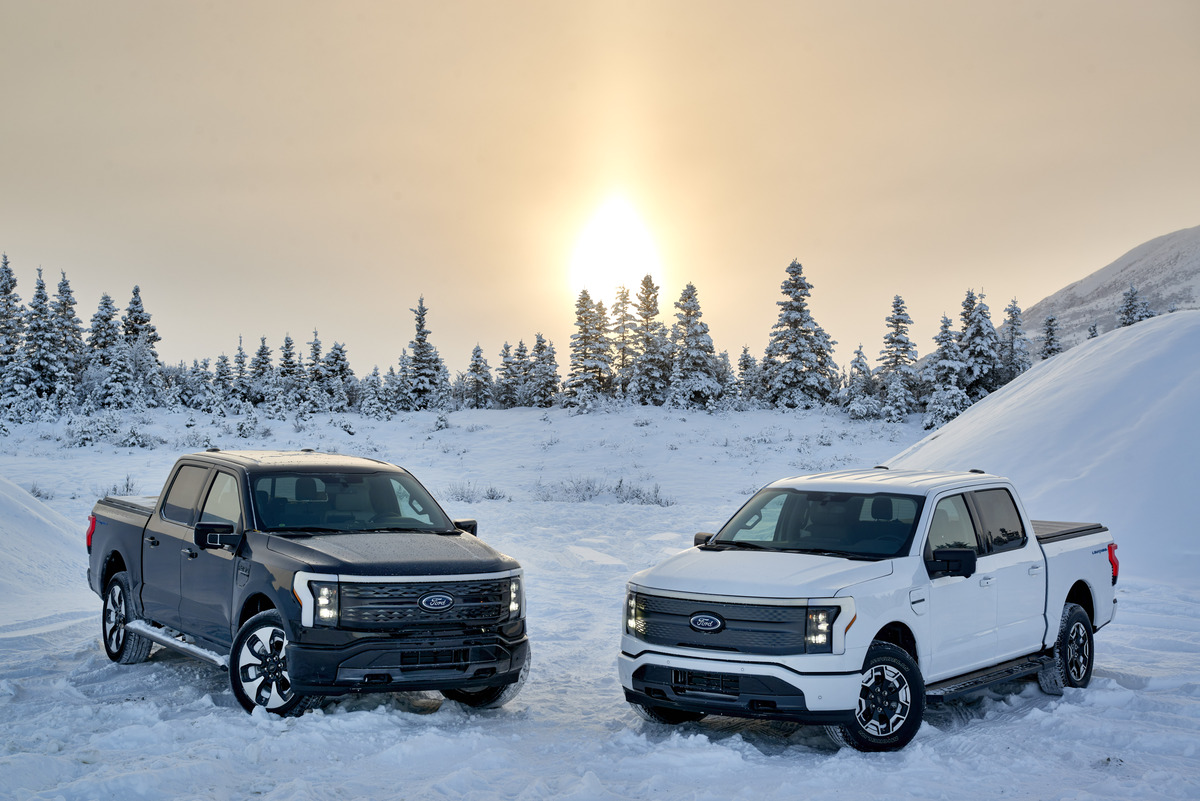
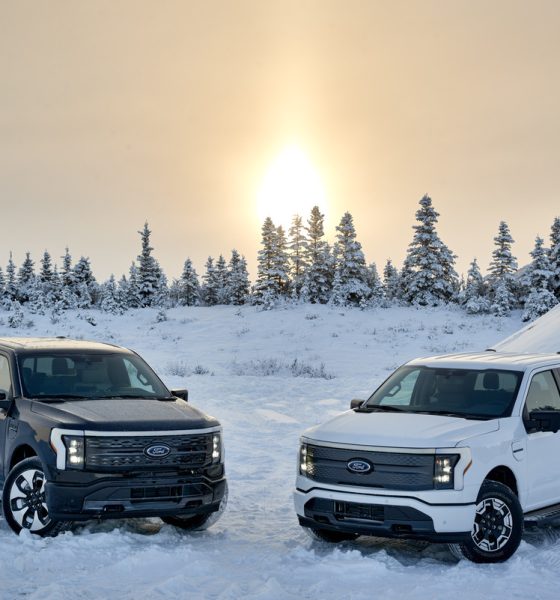
News
Ford used Alaska’s trickiest terrain to test the F-150 Lightning’s all-season capability
Ford is preparing for the first deliveries of its all-electric pickup the F-150 Lightning this Spring. As Ford moves closer to bringing the electric version of its popular pickup series to market, the company has been assessing the vehicle’s performance in some of the most challenging settings, ensuring customers will enjoy the top-notch capabilities the F-series has offered for decades. The F-150 Lightning spent two weeks with Ford engineers in Alaska, providing the vehicle with some of its toughest and trickiest tests to date.
Ford, which saw an over 55 percent increase in electric vehicle sales in February, took its new all-electric pickup to the coldest portions of the frozen Alaskan tundra, assessing the pickup’s performance on low-traction surfaces like snow and ice. The environment also provided another challenge: extremely cold temperatures, which are not always friendly to electric powertrains.
- Preproduction model with optional equipment driven under test conditions. Professional driver on closed course. Do not attempt. 2022 Ford F-150 Lightning production begins spring 2022.
- Preproduction model with optional equipment driven under test conditions. Professional driver on closed course. Do not attempt. 2022 Ford F-150 Lightning production begins spring 2022.
- Preproduction model with optional equipment driven under test conditions. Professional driver on closed course. Do not attempt. 2022 Ford F-150 Lightning production begins spring 2022.
- Preproduction model with optional equipment driven under test conditions. Professional driver on closed course. Do not attempt. 2022 Ford F-150 Lightning production begins spring 2022.
“Alaska provides us the extremely cold temperatures, snow and ice-covered surfaces that we need to push the F-150 Lightning in this type of testing, which is really focused on dialing-in how the truck delivers its power to the ground on slippery surfaces,” Cameron Dillon, an F-150 Lightning powertrain engineer, said. “Customers may not regularly see minus 30-degree mornings like we are seeing here, but they will see winter cold, snow, and icy roads, and they should feel confident their F-150 Lightning is ready for all of it.”
“Alaska provides us the extremely cold temperatures, snow and ice-covered surfaces that we need to push the F-150 Lightning in this type of testing, which is really focused on dialing-in how the truck delivers its power to the ground on slippery surfaces,” Cameron Dillon, an F-150 Lightning powertrain engineer, said. “Customers may not regularly see minus 30-degree mornings like we are seeing here, but they will see winter cold, snow, and icy roads, and they should feel confident their F-150 Lightning is ready for all of it.”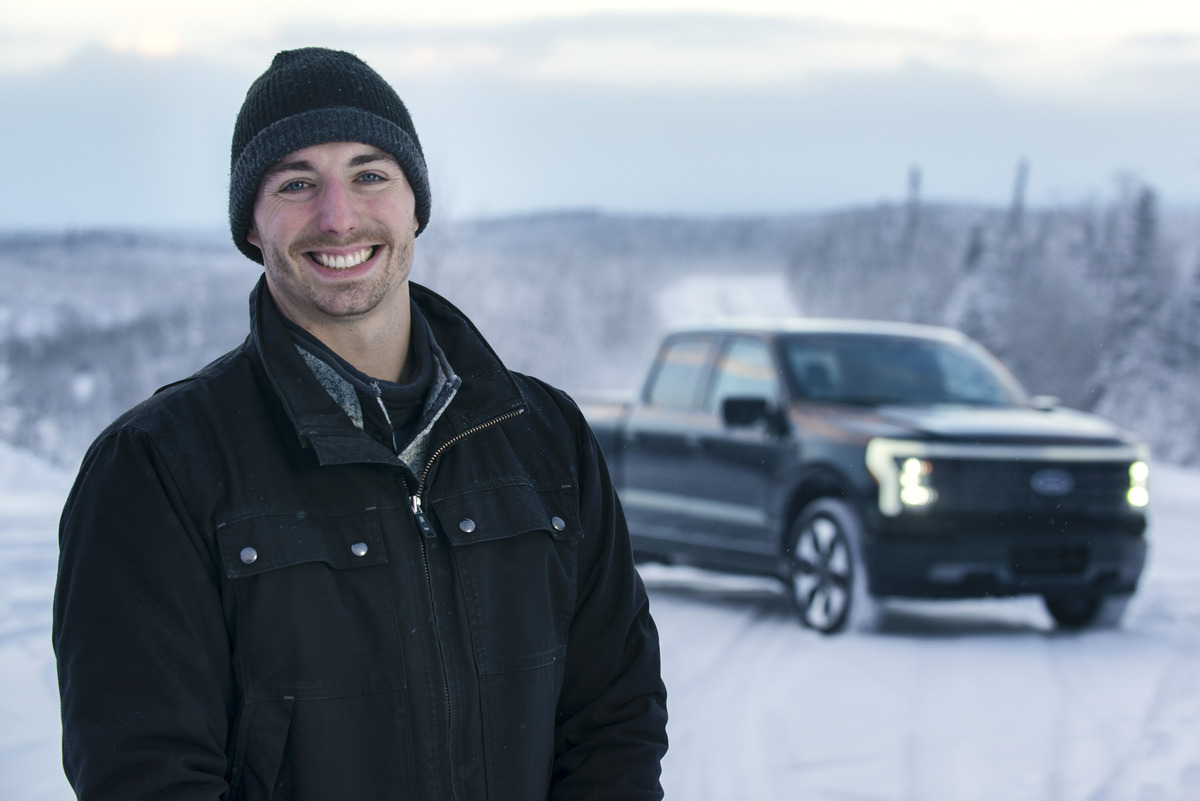
Ford says it performed low-mu testing, an evaluation of an all-electric powertrain and how it adjusts power delivery to the wheels on low-traction surfaces. Snow, ice, and cold temperatures all contribute to the removal of traction from normal driving surfaces like concrete and asphalt. Alaska was an ideal choice, especially as it offered extreme scenarios of what the truck will see on a daily basis.
Ford took six pre-production units of the F-150 Lightning to Alaska for the testing, it said. It also tested the pickup’s performance on a variety of winter weather conditions, including loose and packed snow, half ice-half concrete, and complete ice. The F-150 Lightning’s ability to sense wheel slip and adjust power to the wheels within the blink of an eye helps improve handling. The advantages are just another feature of electric powertrains, Nick Harris, another F-150 Lightning powertrain engineer, said.
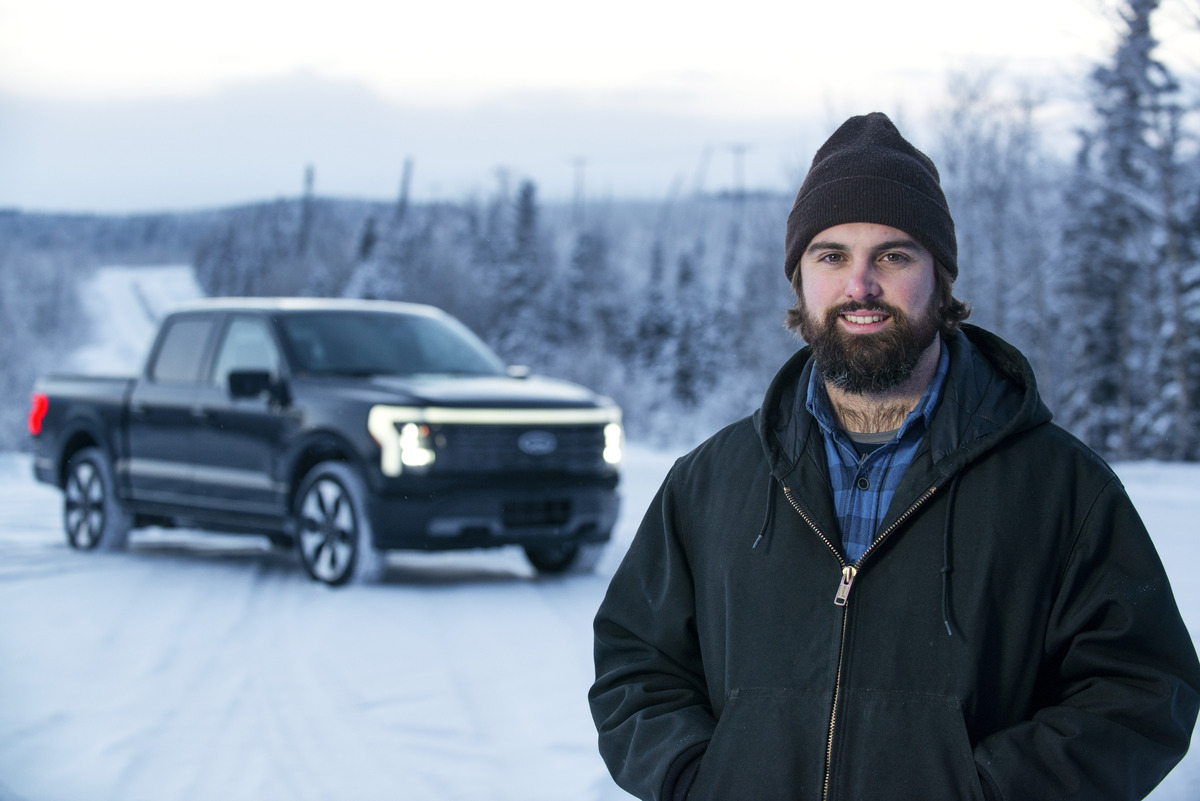
“F-150 Lightning in the snow is a very different ballgame compared to gas vehicles. The responses are extremely quick and the dual motors make it as if you have two engines pumping out power in one vehicle. A lot of our work is to coordinate the two motors to work together to best deliver torque to the ground, so that customers who drive in the snow and ice ultimately feel very confident.”
“F-150 Lightning in the snow is a very different ballgame compared to gas vehicles. The responses are extremely quick and the dual motors make it as if you have two engines pumping out power in one vehicle. A lot of our work is to coordinate the two motors to work together to best deliver torque to the ground, so that customers who drive in the snow and ice ultimately feel very confident.”
The electric F-150 Lightning has six standard benefits that all can be attributed to the use of an electric powertrain, rather than a gas-powered one:
- Standard dual motors front and rear
- Standard always-on 4×4
- Quick torque delivery
- Standard electronic-locking rear differential
- Selectable drive modes
- Low center of gravity for even more confident handling
Ford also can adjust the calibration to help make quick adjustments to the vehicle, making testing more efficient. While the team spent just two weeks in Alaska’s extreme conditions, Ford says the F-150 Lightning Powertrain team also dedicated numerous testing sessions in Michigan’s Upper Peninsula, Borrego Springs, Johnson Valley, and at Ford’s Michigan Proving Grounds near Romeo.
The F-150 Lightning will begin customer deliveries this Spring. Ford recently split its EV and combustion engine operations into two “divisions.” The electric side is known as Model e, while combustion engine projects will fall under the Ford Blue division.
I’d love to hear from you! If you have any comments, concerns, or questions, please email me at joey@teslarati.com. You can also reach me on Twitter @KlenderJoey, or if you have news tips, you can email us at tips@teslarati.com.

News
Tesla (TSLA) receives “Buy” rating and $551 PT from Canaccord Genuity
He also maintained a “Buy” rating for TSLA stock over the company’s improving long-term outlook, which is driven by autonomy and robotics.

Canaccord Genuity analyst George Gianarikas raised his Tesla (NASDAQ:TSLA) price target from $482 to $551. He also maintained a “Buy” rating for TSLA stock over the company’s improving long-term outlook, which is driven by autonomy and robotics.
The analyst’s updated note
Gianarikas lowered his 4Q25 delivery estimates but pointed to several positive factors in the Tesla story. He noted that EV adoption in emerging markets is gaining pace, and progress in FSD and the Robotaxi rollout in 2026 represent major upside drivers. Further progress in the Optimus program next year could also add more momentum for the electric vehicle maker.
“Overall, yes, 4Q25 delivery expectations are being revised lower. However, the reset in the US EV market is laying the groundwork for a more durable and attractive long-term demand environment.
“At the same time, EV penetration in emerging markets is accelerating, reinforcing Tesla’s potential multi‑year growth runway beyond the US. Global progress in FSD and the anticipated rollout of a larger robotaxi fleet in 2026 are increasingly important components of the Tesla equity story and could provide sentiment tailwinds,” the analyst wrote.
Tesla’s busy 2026
The upcoming year would be a busy one for Tesla, considering the company’s plans and targets. The autonomous two-seat Cybercab has been confirmed to start production sometime in Q2 2026, as per Elon Musk during the 2025 Annual Shareholder Meeting.
Apart from this, Tesla is also expected to unveil the next-generation Roadster on April 1, 2026. Tesla is also expected to start high-volume production of the Tesla Semi in Nevada next year.
Apart from vehicle launches, Tesla has expressed its intentions to significantly ramp the rollout of FSD to several regions worldwide, such as Europe. Plans are also underway to launch more Robotaxi networks in several more key areas across the United States.
News
Waymo sues Santa Monica over order to halt overnight charging sessions
In its complaint, Waymo argued that its self-driving cars’ operations do not constitute a public nuisance, and compliance with the city’s order would cause the company irreparable harm.

Waymo has filed a lawsuit against the City of Santa Monica in Los Angeles County Superior Court, seeking to block an order that requires the company to cease overnight charging at two facilities.
In its complaint, Waymo argued that its self-driving cars’ operations do not constitute a public nuisance, and compliance with the city’s order would cause the company irreparable harm.
Nuisance claims
As noted in a report from the Los Angeles Times, Waymo’s two charging sites at Euclid Street and Broadway have operated for about a year, supporting the company’s growing fleet with round-the-clock activity. Unfortunately, this has also resulted in residents in the area reportedly being unable to sleep due to incessant beeping from self-driving taxis that are moving in and out of the charging stations around the clock.
Frustrated residents have protested against the Waymos by blocking the vehicles’ paths, placing cones, and “stacking” cars to create backups. This has also resulted in multiple calls to the police.
Last month, the city issued an order to Waymo and its charging partner, Voltera, to cease overnight operations at the charging locations, stating that the self-driving vehicles’ activities at night were a public nuisance. A December 15 meeting yielded no agreement on mitigations like software rerouting. Waymo proposed changes, but the city reportedly insisted that nothing would satisfy the irate residents.
“We are disappointed that the City has chosen an adversarial path over a collaborative one. The City’s position has been to insist that no actions taken or proposed by Waymo would satisfy the complaining neighbors and therefore must be deemed insufficient,” a Waymo spokesperson stated.
Waymo pushes back
In its legal complaint, Waymo stated that its “activities at the Broadway Facilities do not constitute a public nuisance.” The company also noted that it “faces imminent and irreparable harm to its operations, employees, and customers” from the city’s order. The suit also stated that the city was fully aware that the Voltera charging sites would be operating around the clock to support Waymo’s self-driving taxis.
The company highlighted over one million trips in Santa Monica since launch, with more than 50,000 rides starting or ending there in November alone. Waymo also criticized the city for adopting a contentious strategy against businesses.
“The City of Santa Monica’s recent actions are inconsistent with its stated goal of attracting investment. At a time when the City faces a serious fiscal crisis, officials are choosing to obstruct properly permitted investment rather than fostering a ‘ready for business’ environment,” Waymo stated.
News
Tesla FSD v14.2.2 is getting rave reviews from drivers
So far, early testers have reported buttery-smooth drives with confident performance, even at night or on twisty roads.

Tesla Full Self-Driving (Supervised) v14.2.2 is receiving positive reviews from owners, with several drivers praising the build’s lack of hesitation during lane changes and its smoother decision-making, among others.
The update, which started rolling out on Monday, also adds features like dynamic arrival pin adjustment. So far, early testers have reported buttery-smooth drives with confident performance, even at night or on twisty roads.
Owners highlight major improvements
Longtime Tesla owner and FSD user @BLKMDL3 shared a detailed 10-hour impression of FSD v14.2.2, noting that the system exhibited “zero lane change hesitation” and “extremely refined” lane choices. He praised Mad Max mode’s performance, stellar parking in locations including ticket dispensers, and impressive canyon runs even in dark conditions.
Fellow FSD user Dan Burkland reported an hour of FSD v14.2.2’s nighttime driving with “zero hesitations” and “buttery smooth” confidence reminiscent of Robotaxi rides in areas such as Austin, Texas. Veteran FSD user Whole Mars Catalog also demonstrated voice navigation via Grok, while Tesla owner Devin Olsen completed a nearly two-hour drive with FSD v14.2.2 in heavy traffic and rain with strong performance.
Closer to unsupervised
FSD has been receiving rave reviews, even from Tesla’s competitors. Xpeng CEO He Xiaopeng, for one, offered fresh praise for FSD v14.2 after visiting Silicon Valley. Following extended test drives of Tesla vehicles running the latest FSD software, He stated that the system has made major strides, reinforcing his view that Tesla’s approach to autonomy is indeed the proper path towards autonomy.
According to He, Tesla’s FSD has evolved from a smooth Level 2 advanced driver assistance system into what he described as a “near-Level 4” experience in terms of capabilities. While acknowledging that areas of improvement are still present, the Xpeng CEO stated that FSD’s current iteration significantly surpasses last year’s capabilities. He also reiterated his belief that Tesla’s strategy of using the same autonomous software and hardware architecture across private vehicles and robotaxis is the right long-term approach, as it would allow users to bypass intermediate autonomy stages and move closer to Level 4 functionality.

